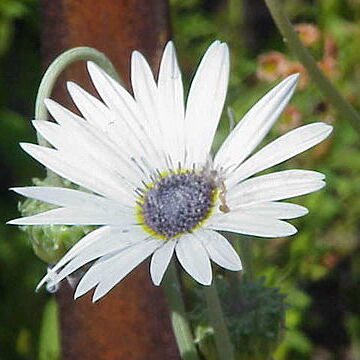Tufted herb, 0.08-0.60 m high. Leaves petiolate, lyrate-pinnatifid, grey-tomentose on both sides. Involucre with bracts in many rows, outer bracts white-tomentose, acuminate, apex shortly reflexed. Ray florets female, fertile, limb white with yellow basal band. Disc florets many, outer florets hermaphrodite, inner florets male or sterile, corolla mauve-purple. Filaments smooth. Flowering time mainly Oct.-Mar. Pappus of scales in 2 unequal rows, inner scales much longer than outer scales, apex rounded-obtuse, longer than cypsela. Cypselae obconical, white-woolly on adaxial side, 3 abaxial wings forming 2 linear-obovate cavities, basal ring of hairs longer than cypsela.
Leaves spathulate to narrowly oblanceolate in outline, expanded in the apical one half to one third and ± gently tapering into a linear petiole-like base, coarsely remotely serrate or sinuate-dentate to lyrate-pinnatilobed with 2–5 lobes on each side, obtuse at the apex, semi-amplexicaul to subauriculate at the base, thinly araneose; the expanded part strongly 3(5)-nerved from near the base; basal leaves of rosulate plants crowded, mostly 10–20 x 2–4 cm., ± spathulate; upper leaves more remote, mostly up to c. 9 cm. long, oblanceolate.
Involucres 12–15 mm. long and 12–20 mm. in diam., broadly cupuliform; the outer 2–3 series ofphyllaries 2–4 mm. long, produced at the apex into a ± abruptly narrowed oblong-oblanceolate appendage 2–4 mm. long, often recurved, araneose outside; inner phyllaries up to c. 13 x 6 mm., oblong usually widening towards the apex, margins scarious-hyaline to broadly so about the apex, araneose-lanate and glandular on the back except for the margins and apex.
Annual herb, 0.1-0.6 m high. Basal leaves elliptic-obovate, obtuse, margins deeply sinuate-dentate to pinnatilobate, petiolate; cauline leaves sessile, smaller. Achenes densely pilose, with pappus scales. Flowers with upper surface of rays white to pale yellow, coppery purple to reddish lilac or violet below, disc dark blue-lilac, mauve-blue, blue-black or purple.
Disk-florets very numerous; corollas blue or purplish, funnel-shaped, c. 5 mm. long; the outer 4–5 series of florets hermaphrodite producing achenes similar to those of the ray-florets; the central series ? functionally male with rudimentary ovaries.
Stems short, few to many-branched from near the base, sometimes apparently acaulous with rosulate basal leaves; branches ascending, simple or branching above, leafy, stout, striate-sulcate, araneose to glabrescent, pithy.
Is an annual or perennial herb to 60 cm.. Large white or pink ray florets.. The achenes have 2 deep grooves on one side.
Receptacle membranous-alveolate with the walls produced into setae to c. 4 mm. long.
An erect annual greyish-araneose herb, 8–60 cm. tall from a woody taproot.
Capitula many, solitary and terminal on the main and secondary branches.

